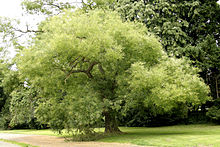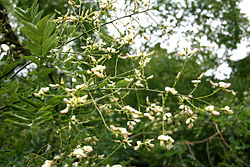- Styphnolobium japonicum
-
Styphnolobium japonicum 
Styphnolobium japonicum tree Scientific classification Kingdom: Plantae (unranked): Angiosperms (unranked): Eudicots (unranked): Rosids Order: Fabales Family: Fabaceae Subfamily: Faboideae Tribe: Sophoreae Genus: Styphnolobium Species: S. japonicum Binomial name Styphnolobium japonicum
(L.) Schott[1][2]Synonyms Styphnolobium japonicum (L.) Schott , the Pagoda Tree (Chinese Scholar, Japanese pagodatree; syn. Sophora japonica) is a species of small tree or shrub in the subfamily Faboideae of the pea family Fabaceae.
It was formerly included within a broader interpretation of the genus Sophora. The species of Styphnolobium differ from Sophora in lacking the ability to form symbioses with rhizobia (nitrogen fixing bacteria) on their roots. It also differs from the related genus Calia (mescalbeans) in having deciduous leaves and flowers in axillary, not terminal, racemes. The leaves are pinnate, with 9-21 leaflets, and the flowers in pendulous racemes similar to those of the Black locust.
Contents
Distribution
Styphnolobium japonicum is native to eastern Asia (mainly China; despite the name, it is introduced in Japan), is a popular ornamental tree in Europe, North America and South Africa, grown for its white flowers, borne in late summer after most other flowering trees have long finished flowering. It grows into a lofty tree 10-20 m tall with an equal spread, and produces a fine, dark brown timber.
Uses
Gardening
The Guilty Chinese Scholartree was a historic Pagoda Tree in Beijing, on which the last emperor of the Ming Dynasty, Chongzhen, hanged himself.
Medicinal uses
S. japonicum (Chinese: 槐; pinyin: huái; formerly Sophora japonica) is one of the 50 fundamental herbs used in traditional Chinese medicine.
Medicinal properties
It has abortifacient, antibacterial, anticholesterolemic, antiinflammatory, antispasmodic, diuretic, emetic, emollient, febrifuge, hypotensive, purgative, styptic, and tonic properties.[3]
Chinese Etymology
The Chinese name for the tree (槐) is composed of the word 木 ("wood") and 鬼 ("demon"). In folklore, it is said that a cowherd once built a home out of this species of tree, and within a month his entire family was suddenly found dead, with no signs of foulplay. It was therefore believed that demons are drawn to this tree and it is therefore not appropriate to use its wood to build homes. In addition, in the wild, other species of tree rarely grow near it.
See also
- Chinese herbology 50 fundamental herbs
References
Footnotes
- ^ "Styphnolobium japonicum information from NPGS/GRIN". USDA. http://www.ars-grin.gov/cgi-bin/npgs/html/taxon.pl?314715. Retrieved 2008-02-19.
- ^ a b c d "Styphnolobium japonicum - ILDIS LegumeWeb". http://www.ildis.org/LegumeWeb?sciname=Styphnolobium+japonicum. Retrieved 2008-02-19.
- ^ "Sophora japonica - Plants For A Future database report". http://www.pfaf.org/database/plants.php?Sophora+japonica. Retrieved 2008-02-19.
General references
- The relationship of Sophora sect. Edwardsia (Fabaceae) to Sophora tomentosa, the type species of the genus Sophora, observed from DNA sequence data and morphological characters. Bot. J. Linn. Soc. 146: 439-446 (2004). Available online.
External links
Categories:- Faboideae
- Trees of China
- Flora of East Asia
- Medicinal plants
- Plants used in Traditional Chinese medicine
- Garden plants of Asia
- Ornamental trees
Wikimedia Foundation. 2010.

